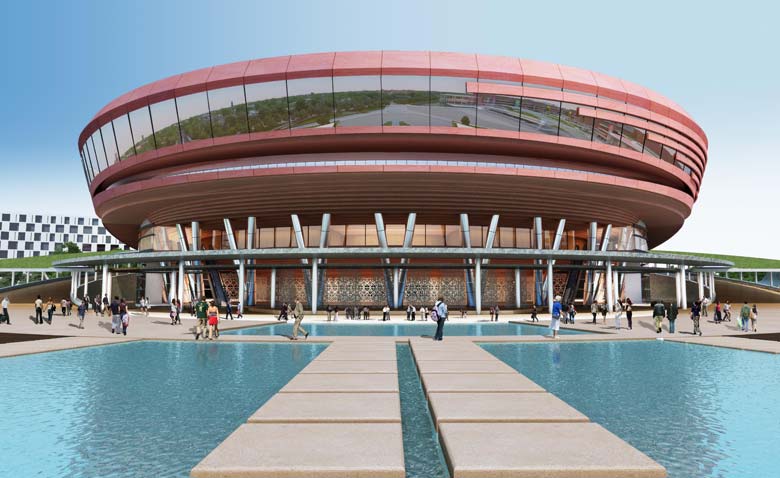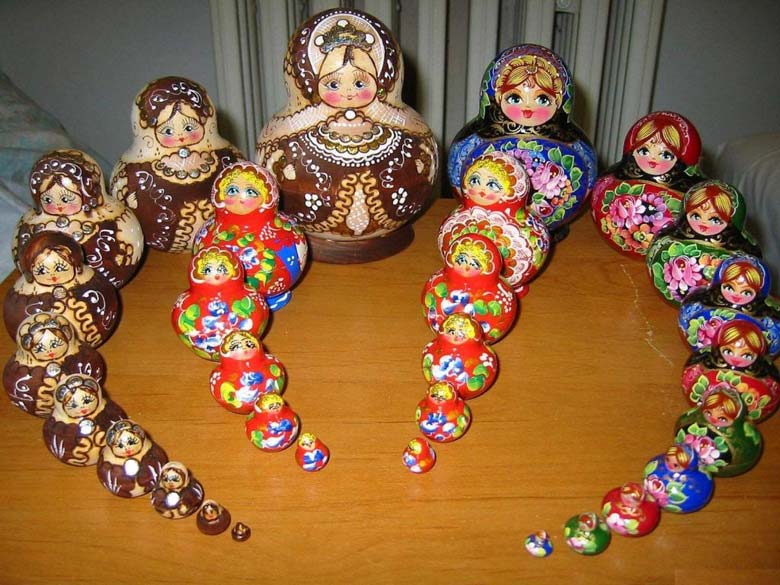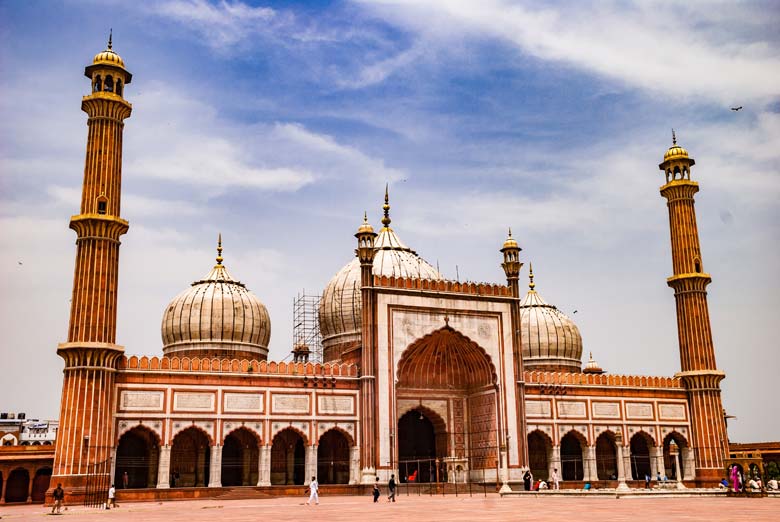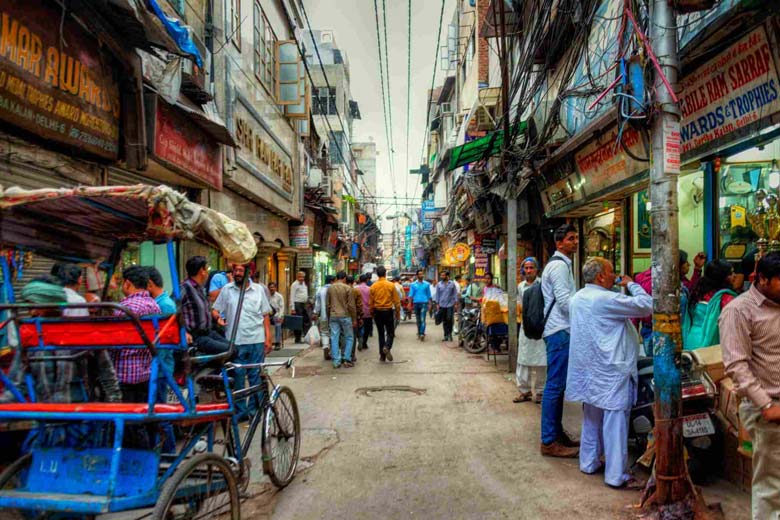1. The Purana Qila
The Purana Qila: or Old Fort, was the citadel of the second of the great Mughal emperors. Humayun (1530-40 and 1555-56), and once stood on the banks of the river Yamuna. Its majestic, crumbling walls lie to the east of the Mathura Road. The fort is believed to mark the site of Indraprastha, the magnificent capital built by the Pandava brothers, the heroes of the Mahabharata epic. There was a village called Inderpat, a derivation of Indra-prastha, actually inside the walls until the British moved it out at the time of the construction of New Delhi. During excavations a kind of pottery called Painted Grey Ware. dating from around 1000 ac, was found in the fort.
Humayun built his capital of Din Panah here. The citadel we see today, however, was the work of Sher Shah Suri (1540-45), an able ruler of Afghan descent, who rebelled against Humayun and forced him to flee the country. During his brief reign Sher Shah reformed the administration and built the Grand Trunk Road. now called Sher Shah Suri Marg. still the country’s main arterial route. His successors were not so competent, and Humayun managed to regain his kingdom.
Opposite the main entrance to the fort, on the other side of the Mathura Road, you see the impressive Sher Shah gate, thought to be one of the entrances to the sprawling city of Delhi over which the Afghan ruled. Beside it to the north is the Khairu’l Manazil Mosque built in 1561, during the reign of the emperor Akbar. The drive to the main western gateway of the fort is lined by stalls vending tea, snacks and ice cream. The double-storey gate is built of red sandstone, and topped by chatris.
Two outstanding buildings remain. The first is the attractive Qal’a-i-Kuhan mosque, built by Sher Shah in 1541 on one of the highest points in the fort. The mosque is midway in style between the solid mosques of the Sultanate period, and the graceful ones of the later Mughal period. Nearby is an octagonal pavilion of red sandstone known as the Sher Mandal. It is believed to have been the library of Humayun, from where he slipped down the stairs to his death. Surrounded by trees is Maharani Kunti’s temple. where there is an image of Kunti, the mother of the Pandavas.
From the ramparts you look out over the main railway line between Delhi and Mumbai. To the north are the modern pavilions of Delhi’s Exhibition Grounds, and to the south the green expanse of the National Zoological Park. Underneath the eastern walls of the fort, by the Pragati Maidan bus stand, is the Bhairon temple, popular with Delhiites, who offer libations of whisky to Bhairon, a form of Shiva. This temple reputedly dates back to the Mahabharata era, and the main images of Bhairon, the monkey god Hanuman and the Pandava brother Bhima, are rocks painted silver and orange with great eyes. A more modern image of Bhairon shows him holding a human head in one hand and a bottle in the other. At his feet is the black dog which is his mount.
2. Pragati Maidan

Pragati Maidan Delhi
North of the Purana Qila: Pragati Maidan hosts the international trade fair each November. and numerous other fairs throughout the year. It also has a fun fair called Appu Ghar, after Appu the Elephant who was the mascot of the Asian Games in 1982. On the other side of the road are the domes of India’s Supreme Court.
3. Matka Shah

Matka Shah Delhi
Near the junction of the Mathura Road and Bhairon Marg. next to the museum, is the shrine of a Muslim saint, known as Matka Shah. From the road you can see trees festooned with large, round clay water-pots called matkas. The saint’s tomb stands here on a small hill which, in the 13th century, was on the banks of the Yamuna. The saint attracted a following and the Sultan Balban is said to have tested him by sending him mud and iron as a gift of food. The saint’s prayers turned the iron into chickpeas and the mud into jaggery (sugar derived from date palm sap). The water in his matka turned miraculously to milk and all the assembled populace were fed. Nowadays visitors come to the tomb for help and if their wishes are granted they return with a matka, chickpeas, sugar and milk as thanks.
4. International Doll Museum

International Doll Museum Delhi
At the northern end of the Mathura Road is a major road junction. The turning to the north is Bahadur Shah Zafar Marg, India’s Fleet Street. Here are the offices of two of the country’s leading dailies. The Times of India and the Indian Express and their Hindi language publications, the Navbharat Times and the Jansatta. Here too, in Nehru House, is Shankar’s International Doll Museum.
Just north of the newspaper offices is a turning into a large parking area by the walls of Feroze Shah Kotla, the fifth city of Delhi. built by Feroze Shah Tughlaq (1351-88). Its citadel once lay on the banks of the Yamuna. Unfortunately, little remains of the splendour of Feroze Shah’s capital, as much of the more useful stone was carted off in the 17th century to build what is now known as Old Delhi.
The citadel was made up of two large quadrangles. The northern ruins arc set in a pleasant park. You enter through the remains of a huge barbicaned gate. Inside, the most remarkable monument resembles a step pyramid on top of which stands a polished stone Ashokan pillar. This pillar had been set up in Ambala on the orders of the emperor Ashoka (273-232 BC). Feroze Shah ordered that it be brought to Delhi to be a monument for future generations. Ingeniously, a huge bed of silk cotton was prepared, into which the column fell when it was removed from its base, and a carriage with 42 wheels, pulled by over 8,000 men, took it to the banks of the Yamuna from where it was transported to Delhi by boat.
5. Jama Masjid

Jama Masjid Delhi
Nearby is the Jama Masjid, one of the largest mosques of the Sultanate period, built in 1354. It stands on a base in which there are a number of cells. Amir Timur, the Tamerlane or Tamburlaine of English literature, and an ancestor of the Mughals, prayed in the mosque after plundering the city in 1398. He returned to Samarkand soon after, his caravan loaded down with goods and captives, including skilled craftsmen to help build his capital.
The southern quadrangle of Feroze Shah Kotla is occupied by the village of Vikramnagar. The village appears to have been in its place under the walls for centuries. In fact, most of the inhabitants are refugee families from Pakistan who came to Delhi in 1947 and are still waiting to be given permanent accommodation by the government. To the north of the ruins are the famous Feroze Shah Kotla cricket grounds. where most test matches in Delhi are played, and the Ambedkar stadium.
6. Khuni Darwaza

Khooni Darwaza Delhi
In the centre of Bahadur Shah Zafar Marg. just north of the entrance to the ruins and opposite the Maulana Mad Medical College, stands the Khuni Darwaza, or Bloody Gate. It was here that Lieutenant Hodson shot dead two sons of the last Mughal, Bahadur Shah Zafar, in 1858.
7. National Zoological Park

National Zoological Park Delhi
South of the Purana The National Zoological Park, which covers 75 hectares (186 acres), houses some 1,600 animals and attracts nearly three million visitors a year. The zoo is also a great attraction for migratory ducks and other wild birds. During the winter several thousand pintails, spotbills, common teal and shovelers share the ponds. Between September and November painted storks nest in the trees, while the heronry is active roughly between April and July. The zoo keeps rare white tigers and has been successful in breeding the endangered lion-tailed macaque and brow-antlered deer.
8. Sunder Nagar Market

Sunder Nagar Market Delhi
Heading south down the Mathura Road from the zoo entrance you pass Sunder Nagar Market. During the festival of Diwali, you have to fight through the crowds and plead with the staff before you can buy sweets here. There are also several reliable jewellers and craft shops which specialise in antiques, or high quality reproductions.
Further south you come to a historic roundabout at the junction of Lodi Road and the Mathura road, which has in its centre an octagonal tomb with a double dome covered with tiles. This tomb dates from the early Mughal period, and is the only one in Delhi built in a typical Central Asian style. Its name, Sabz Burj, means “Green Tower”, but the new tiles fixed on its dome by the Archaeological Survey are bright blue.
9. Humayun’s tomb

Humayun’s Tomb Delhi
The eastern turning from the round-about takes you to the gates of Humayun’s tomb, the finest Mughal building in Delhi and architecturally the predecessor of the Taj Mahal at Agra. Passing through the modern iron gates you enter Bu Halima’s garden. The southern wall of the garden has steps leading through a stone doorway into an octagonal enclosure with the air of a secret garden. In the centre is the octagonal tomb of Isa Khan, a nobleman at the court of Sher Shah Suri. A small, three-domed mosque is attached to it, with some of its original turquoise tiles intact.
At the end of Bu Halima’s garden is a large gate, where you buy entrance tickets for the tomb. Beyond is an avenue of banyan trees leading to the tomb’s main gate. To the right of the gate is the entrance to a garden in which stand Afsarwala’s mosque and tomb.
The main gate to the mausoleum, like the one before it, is aligned perfectly with the centre of the monument. It acts as a screen, and your first glimpse inside it is like looking into another world. Humayun’s tomb stands on a raised platform and is built mainly of red sandstone. Its symmetrical arches are surmounted by a white marble dome, with chatris around it.
The Emperor Humayun’s senior widow, Bega Begum, supervised the construction, which was completed in 1565. The emperor’s grave lies at ground level in a chamber occupied by bats, and his cenotaph is above in the tomb’s main hall underneath the double dome. The last Mughal, Bahadur Shah Zafar, took refuge in the tomb after Delhi fell to the British in 1858.
10. Damdama Sahib

Sisganj Gurudwara
The tomb stands in a Mughal garden, divided into squares by water channels. To the southeast of Humayun’s tomb is the smaller Barbar’s Tomb. Barbar’s identity remains a mystery. There is a pavilion on the garden’s eastern wall which once would have looked out over the Yamuna. Now the view is of the railway line. To the south is the turquoise-tiled Nila Gumbad, or Blue Dome, a tomb believed to have been built in 1625 for the faithful retainer of a nobleman. To the north is the shiny white dome of the recently built gurudwara, or Sikh temple, Damdama Sahib. The gurudwara marks the spot where the last of the Sikh Gurus, Guru Gobind Singh, met the Mughal emperor Bahadur Shah in 1707 The emperor wanted to stage an elephant fight between his elephant and the Guru’s. But the Guru maintained that a male buffalo of Punjab was as good as any imperial elephant and, the Sikhs say, he was right: the imperial elephant fled in terror from the buffalo.
The road to the gurudwara runs around the northern walls of Humayun’s tomb, past the Sundar nursery to the north, and the Bharat Scouts and Guides Training Centre.
11. Hazrat Nizamuddin

Hazrat Nizamuddin Dargah
Opposite the New Horizon School is a small and peaceful dargah, enshrining the remains of a contemporary of Hazrat Nizamuddin. Beside the tomb of this saint is a tree said to be over 750 years old, which, according to local people, produces sugar from its leaves at the height of summer. Devotees eat the leaves of this tree to solve their problems, and tie coloured threads around its trunk. Hence the name of the shrine—the Patte Wali Dargah (Shrine of Leaves).
Back on the Mathura road heading south, you pass through the residential area of Nizamuddin. To the east, near the turning to Nizamuddin Railway Station, is the massive square tomb of Abd’ur Rahim Khar Khan-i-Khanan, a poet and general who served the Mughal emperors Akbar and Jahangir, and died in 1627.
West of Humayun’s Tomb: Driving westwards down Lodi Road, you pass the Muslim village of Nizamuddin, tall blocks of government buildings, and the huge floodlights of the Jawaharlal Nehru stadium, built for the Asian Games in 1982, to the south. On the northern side of the road is Delhi’s Golf Course and Lodi Gardens, named after the Lodi dynasty which preceded the Mughals. During weekends it is invaded by picnickers. Amongst all this activity stand plain stone tombs of the Sultanate period.
To the south, near the Lodi Road, is the octagonal tomb of Muhammad Shah (1434-44) of the Saiyyid dynasty.
In the centre of the park is the Bara Gumbad, or Great Dome, an imposing tomb of a nobleman of the Lodi period.
Adjoining it is a mosque of ashlar stone, decorated with inscriptions from the Quran. About 50 m (160 feet) to the north is a large, square tomb known as the Shish Gumbad, or Glazed Dome. It dates from the Lodi period although the occupant is unknown. Sikandar Lodi (1489-1517) is buried in an octagonal tomb which stands in a walled enclosure in the northern part of the gardens, near an ornamental lake. Over the lake is a Mughal bridge, probably built in the latter half of the 16th century.
12. India International Centre

India International Centre
Along the eastern side of the gardens runs Lodi Estate, site of the India International Centre, a club with a fine library and well patronised bar open to members only. However, the frequent concerts of music and dance held in its auditorium are open to the general public.
13. Khan Market

Khan Market Delhi
Northeast of the gardens is Khan Market, which sells everything from spare parts for cars to fruit and flowers, Marmite and medicines. It also has several good bookshops which specialise in books on India.
14. Safdarjang’s tomb

Safdarjang’s tomb
At the western end of Lodi Road is one of the city’s main landmarks, Safdarjang’s tomb. Its bulbous white dome rises above the walls of the extensive Mughal garden surrounding it. The mausoleum is faced with stone removed from Khan-i-Khanan’s tomb in Nizamuddin, and it represents the final flowering of Mughal architecture in Delhi. Safdarjang was a powerful nobleman at a time of enfeebled emperors, and played a major role in the civil wars which shook the kingdom during his lifetime. He was also one of the founders of the ruling family of Avadh, who governed independently of the emperor in Delhi and developed the city of Lucknow into a centre of cultural and artistic excellence. Shuja-ud-Daula, Safdarjang’s son and successor in Avadh, spent 300,000 rupees on his father’s tomb, the last great mausolea to ti be built in the Mughal capital.
The tour packages promoted by Swan Tours showcasing Delhi are Delhi Sightseeing Tour by Car , Delhi Jaipur and Agra with Fatehpur Sikri Tour and more , For Details visit swantour.com

